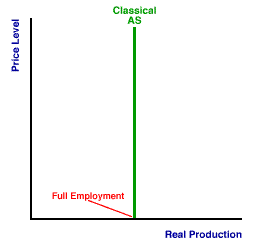
|
|
THIRD ESTATE: In past centuries, this included the peasants, serfs, or slaves who performed the dirty deeds for the ruling elite. In modern times, this is the workers, taxpayers, and consumers who have limited ownership of and control over resources usually nothing more than their own labor. The third estate, which forms the backbone of any modern economy, is usually at odds with the business leaders of the second estate. Help may come from the government leaders of the first estate or the journalist of the fourth estate--but don't count on it.
Visit the GLOSS*arama
|
|


|

|
                           CLASSICAL AGGREGATE SUPPLY CURVE: An aggregate supply curve--a graphical representation of the relation between real production and the price level--that reflects the basic principles of classical economics. The classical aggregate supply curve is vertical at the full-employment level of real production indicating that the quantity of aggregate production is independent of the price level. An alternative is the Keynesian aggregate supply curve. An aggregate supply curve is a graphical representation of the relation between real production and the price level. Classical economics implies that the full-employment level of real production is maintained regardless of the price level, which creates a vertical, or perfectly elastic, aggregate supply curve. This relation results due to flexible prices, which ensure that resources markets maintain equilibrium balance at full employment. Should the price level rise or fall, wages and resource prices adjust to ensure that quantity demanded equals quantity supplied in resource markets.| Classical AS Curve |  |
The exhibit to the right illustrates a classical aggregate supply (AS) curve. The obvious characteristic is that the curve is actually a vertical line. The line is vertical at the full-employment level of real production. Should the price level rise or fall, the economy moves up and down along the curve and real production remains unchanged.The full-employment level of real production corresponds to the natural unemployment rate, also termed the non-accelerating inflation unemployment rate. The measured unemployment rate is not necessarily zero. This rate includes both frictional unemployment and structural unemployment and results if the quantity of labor demanded is equal to the quantity of labor supplied. The classical aggregate supply curve looks a great deal like the long-run aggregate supply curve. Both are vertical at the full-employment level of real production. Both indicate that real production is unaffected by changes in the price level. The reason for the similarity is that the long-run aggregate supply curve is the modern embodiment of the principles of classical economics. For the classical aggregate supply curve, changes in the price level results in changes in wages and resource prices that ensure equality between quantity demanded equals quantity supplied in resource markets. For the long-run aggregate supply curve, changes in the price level results in changes in wages and resource prices that ensure equality between quantity demanded equals quantity supplied in resource markets--in the long run.

Recommended Citation:CLASSICAL AGGREGATE SUPPLY CURVE, AmosWEB Encyclonomic WEB*pedia, http://www.AmosWEB.com, AmosWEB LLC, 2000-2025. [Accessed: July 18, 2025].
Check Out These Related Terms... | | | | | | |
Or For A Little Background... | | | | | | | | | | | | | | | |
And For Further Study... | | | | | |
Search Again?
Back to the WEB*pedia
|



|

|
BEIGE MUNDORTLE
[What's This?]
Today, you are likely to spend a great deal of time strolling around a discount warehouse buying club hoping to buy either a case for your designer sunglasses or arch supports for your shoes. Be on the lookout for crowded shopping malls.
Your Complete Scope
This isn't me! What am I?
|

|
|
John Maynard Keynes was born the same year Karl Marx died.
|

|
|
"A winner is someone who recognizes his God-given talents, works his tail off to develop them into skills, and uses those skills to accomplish his goals. " -- Larry Bird, basketball player
|

|
ABA
American Bankers Association, Associate in Business Administration
|

|
|
Tell us what you think about AmosWEB. Like what you see? Have suggestions for improvements? Let us know. Click the User Feedback link.
User Feedback
|


|


